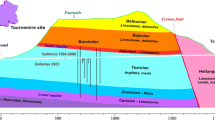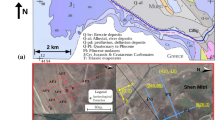Abstract
The landslide of Kef Essenoun phosphate deposit (northeast of Algeria) occurred on September 2007, when a large mass of rocks detached from the rock mass scale and filled almost entirely the pit (the career). Recently, new cracks oriented N–S and NE–SW with large sizes have appeared in several places near a slide area and even in the alignment of the 2007 slide area. To understand the nature of the deformations recently observed at the surface, and to favor safety measures that can be implemented rapidly, it is essential to obtain maximum information on the deep structure of underground cracks and areas of weakness. Electrical resistivity imaging or tomography (ERT) is well suited for characterizing the bedrock surface thanks to the ability of the technique for detecting resistive features as well as discriminating subtle resistivity variations. For the present investigation, a Wenner transect was conducted through a visible crack area near the landslide area. The electrode spacing was 2 m and the length of the transect was about 60 m. In this case study, the survey results suggest that ERT is a cost-effective tool that can easily be deployed to gather valuable subsurface data and to aid in the detecting and mapping of underground cracks and other subsurface cavities.







Similar content being viewed by others
References
Al-Amoush, Abou Karaki (1997) Practical quantification of the anisotropy factor in electrical resistivity measurements, application on water exploration in Jordan. MSc. Thesis, Univ. of Jordan
Annan AP, Cosway SW, Redman JD (1991) Water table detection with ground-penetrating radar. In: Soc Explor Geophys (Annual International Meeting Program with Abstracts), pp 494–497
Ballard RF (1983) Cavity detection and delineation research. Report 5, electromagnetic (radar) techniques applied to cavity detection. Technical Report GL, 83–1, pp 90
Bishop I, Styles P, Emsley SJ, Ferguson NS (1997) The detection of cavities using the microgravity technique: case histories from mining and karstic environments. Geol Soc Eng Geol Spec Publ 12:153–166
Bogoslovsky VA, Ogilvy AA (1977) Geophysical methods for the investigation of landslides. Geophysics 42:562–571
Butler DK (1984) Microgravimetric and gravity gradient techniques for detection of subsurface cavities. Geophysics 49(7):1084–1096
Colley GC (1963) The detection of caves by gravity measurements. Geophys Prospect XI:1–9
Cook JC (1965) Seismic mapping of underground cavities using reflection amplitudes. Geophysics 30(4):527–538
Cook KL, Van Nostrand RG (1954) Interpretation of resistivity data over filled sinks. Geophys Prospect 21:716–723
Cosenza P, Mannet E, Rejiba F (2006) Correlations between geotechnical and electrical data: a case study at Garchy in France. J Appl Geophys 60:165–178
EREM (1987) Travaux de prospection et d’évaluation des phosphates de Djebel Onk, 2 tomes: géologie, 50p.; prospection et évaluation. Report, 53p
Fehdi C, Baali F, Boubaya D, Rouabhia A (2011) Detection of sinkholes using 2D electrical resistivity imaging in the Cheria Basin (north–east of Algeria). Arab J Geosci 4:181–187
Frohlich RK, Kelly WE (1985) The relation between hydraulic transmissivity and transverse resistance in a complicated aquifer of glacial outwash deposits. J Hydrol 79:215–219
Hong Y, Adler RF, Huffman G (2007) An experimental global prediction system for rainfall-triggered landslides using satellite remote sensing and geospatial datasets. IEEE Trans Geosci Remote Sens 45(6):1671–1680
Jomard H, Lebourg T, Tric E (2007) Identification of the gravitational boundary in weathered gneiss by geophysical survey: La Clapière landslide (France). J Appl Geophys 62:4757. doi:10.1016/j.jappgeo.2006.07.003
Kassatkine Y, Yahyaoui A, Chatilov S (1980) The works of prospecting and assessment on phosphate executed in 1976–1978 in the mining district of Djebel Onk. SONAREM (Société Nationale de Recherche et d’Exploration Minière) Internal report,vol. 2, Algeria, pp 140
Keller GV, Frischknecht FC (1966) Electrical methods in geophysical prospecting. Pergamon Press Inc., Oxford
LaMoreaux PE, Wilson BM, Memon BA (1984) Guide to the hydrology of carbonate rocks. UNESCO, France
Lee CC, Yang CH, Liu HC, Wen KL, Wang ZB, Chen YJ (2008) A study of the hydrogeological environment of the lishan landslide area using resistivity image profiling and borehole data. Eng Geol 98:3–4. doi:10.1016/j.enggeo.2008.01.012
Morelli G, Labrecque DJ (1996) Advances in ERT inverse modelling. Eur J Environ Eng Geophys 1:171–186
Nadim F, Kjekstad O, Peduzzi P, Herold C, Jaedicke C (2006) Global landslide and avalanche hotspots. Landslides 3(2):159–173
Nouioua I, Aek R, Fehdi CH, Boukaloul M, Gadri I, Chabou D, Mouici R (2013) The application of GPR and electrical resistivity tomography as useful tools in detection of sinkholes in the Cheria basin (northeast of Algeria). Environ Earth Sci 68:1661–1672
Orellana E (1972) Two and three layer master curves and auxiliary point diagrams for vertical electrical sounding using Wenner arrangement. Interciencia Publisher, Venezuela
Parasnis DS (1997) Principles of applied geophysics, 5th edn. Chapman & Hall, London
Rybakov M, Goldshmidt V, Fleischer L, Rotstein Y (2001) Cave detection and 4-D monitoring: a microgravity case history near the Dead Sea. Lead Edge Soc Explor Geophys 20(8):896–900
Schrott L, Saas O (2008) Application of field geophysics in geomorphology: advances and limitations exemplified by case studies. Geomorphology 93:55–73
Telford WM, Geldart LP, Sheriff RE (1990) Applied geophysics, 2nd edn. Cambridge University Press, New York
Zhou W, Beck BF, Adams AL (2002) Effective electrode array in mapping karst hazards in electrical resistivity tomography. Environ Geol 42:922–928
Acknowledgments
This work has been realized through the framework of SOMIPHOS Company. We would like to thank Mr. Boubakeur Aouich, the head of CERAD SOMIPHOS Company, Algeria.
Author information
Authors and Affiliations
Corresponding author
Rights and permissions
About this article
Cite this article
Nouioua, I., Fehdi, C., Boubaya, D. et al. Mapping underground cracks using 2D electrical resistivity tomography: the case of the landslide of Kef Essenoun phosphate deposit, Djebel Onk (northeast of Algeria). Arab J Geosci 8, 7731–7738 (2015). https://doi.org/10.1007/s12517-014-1769-0
Received:
Accepted:
Published:
Issue Date:
DOI: https://doi.org/10.1007/s12517-014-1769-0




